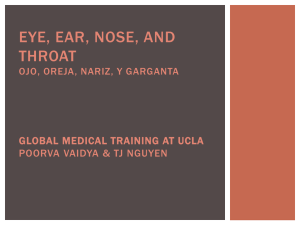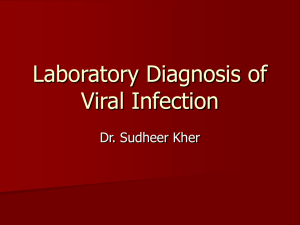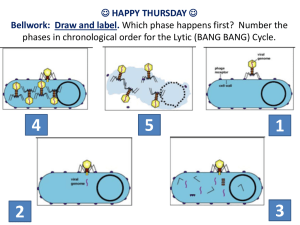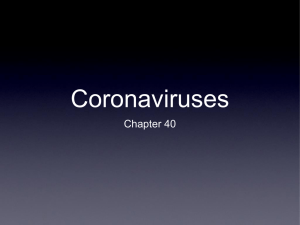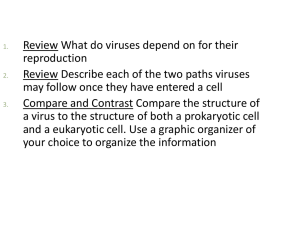PowerPoint 演示文稿
advertisement
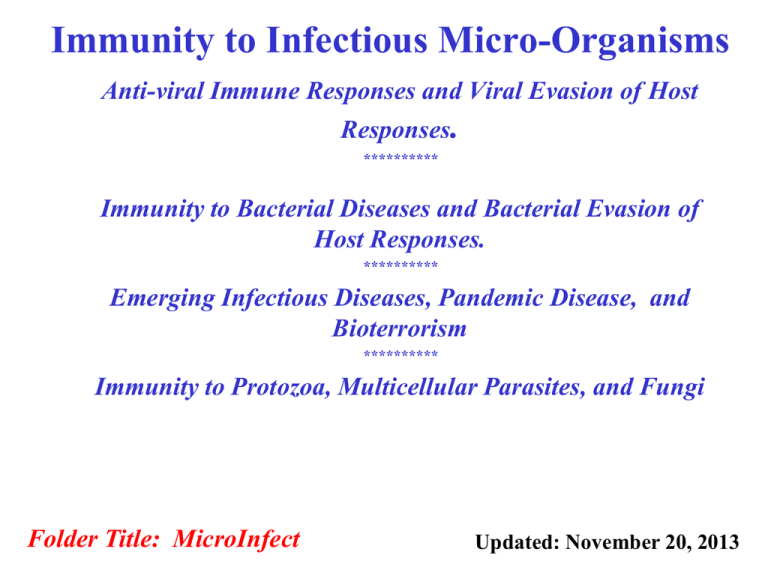
Immunity to Infectious Micro-Organisms
Anti-viral Immune Responses and Viral Evasion of Host
Responses.
**********
Immunity to Bacterial Diseases and Bacterial Evasion of
Host Responses.
**********
Emerging Infectious Diseases, Pandemic Disease, and
Bioterrorism
**********
Immunity to Protozoa, Multicellular Parasites, and Fungi
Folder Title: MicroInfect
Updated: November 20, 2013
Infectious Agents Pathogenic for Humans
and for Veterinary and Farm Animals (Part 1)
Viruses
• Enveloped RNA Viruses (HIV, Influenza, Hepatitis C)
• Naked RNA Viruses {Polio, Hepatitis A, Rhino-viruses (common cold)}
• Enveloped DNA Viruses
(Herpes Simplex, Epstein Barr – Mononucleosis, Variola major - Smallpox,
Vaccinia - cowpox, Hepatitis B)
• Naked DNA Viruses (Adeno-viruses; SV40 Virus; Polyoma viruses)
“Envelop” = lipid bilayer membrane, host-derived;
Contains proteins and glycoproteins derived from pathogen or from the host.
Bacteria
• Gram Positive (No 2nd cell envelop) - Anthrax, Staphylococci, Streptococci
• Gram Negative (2nd Cell envelop with membrane endotoxins) - E coli
• Extra-cellular (i.e. pathogen is outside of host cells):
Neisseria gonorrhoeae; Streptococcal pneumonia
• Intracellular (i.e. pathogen gets inside of host cells):
Listeria Monocytogenes; Tuberculosis; Typhus (rickettsia)
• Exotoxin Producers: Diptheria, Anthrax, Botulism, Tetanus, Yersinia pestis
Infectious Agents Pathogenic for Humans
and for Veterinary and Farm Animals (Part 2)
Protozoans
• Plasmodium falciparum - Malaria
• Trypanosoma brucei - Sleeping Sickness
• Trypanosoma cruzei - Chagas Disease
Fungal (Yeast) Diseases
• Ring-worm; Athletes feet
• Candidiasis
• Oral "Thrush"; Other opportunistic fungal pathogens
Multi-Cellular Parasitic Diseases
• Parasitic Worms - (Helminths)
• Schistosomiasis (worm pathogen transmitted by snails
Pathogenicity of Infectious
Diseases in Humans
1 Billion Infected World-Wide
15 Million Deaths per Year
Greatest Impact in Third-World Countries
• No Economic Incentive to Develop Treatments
• Potential Liabilities in Testing and from Failures
Significance of the "Global Village”
• Emergence of resistance to Tuberculosis
• Emigration of cholera and leishmaniasis
• Disease survival in susceptible patient pools
– polio; measles
• Pandemic Influenza
Infectious
Diseases in
1996
From Kuby
Immunology, 4th Ed.
p. 426
Viral and Bacterial
Viral, Bacterial and Protozoan
Bacterial
Protozoan
Viral
Viral
Viral and Bacterial
Bacterial
Protozoan
Protozoan
Viral
Protozoan
Multi-cellular (Helminth)
Multi-cellular (Helminth)
Viral
Multi-cellular (Helminth)
Infect1996
Causes of Death - Worldwide
p. 448
Non-Immunological Host Barriers to Infection
Epithelial Surfaces
• Gastrointestinal, respiratory, genito-urinary linings
• Ciliated epithelium and mucous secretions
• Epidermal barriers
Cellular Secretions
• Biochemical barriers : Enzymes (can come from innate
immune response system)
• Chemical barriers: pH, oxidants (can come from innate
immune responses)
Physical Barriers
Elevated Temperature (Fever)
Cellular Competition: Gut flora
Innate Natural Immune Responses
to Infectious Agents
Gram-positive Bacteria - Peptidoglycan (exposed)
• Activates alternative complement pathway - C3b
• Opsonizes Bacteria for Enhanced Host Phagocytosis
Gram-negative Bacteria - 2nd Envelope over Peptidoglycan
•
•
•
•
Bacterial Endotoxins - e.g. Lipopolysaccharide
Stimulates Cytokines (TNF, IL-1, IL-6)
From Macrophages and endothelial cells
Activates Macrophages
Interferon Stimulation by Viral Infectious Agents
• Can Directly inhibit viral production
• Can activate and stimulate NK Cells to attack virally infected cells
• Possibly by viral effect on MHC Class I Protein Synthesis
Innate Natural Immunity and AntiViral Responses
Type I Interferons (IFN and IFN)
• Produced by Virally-infected Cells
• Also from Monocytes, Macrophages, and Fibroblasts
Mechanims of Action of IFN and IFN
• Infected cell produces membrane receptors for IFN and
• Activates an RNAase that cleaves viral RNA
• Inactivates viral protein synthesis by effects on dsRNA-dependent
protein kinase
• Induces Anti-viral response and resistance to intra-cellular viral
replication
NK Cells
• Activated by IFN and IFN; become cytotoxic for virallyinfected cells
• Also activated by IL-12 - produced in response to viral infection
Humoral Immunity & Anti-Viral Responses
Antibody-mediated Anti-viral Responses
• Prevent initial infection or reinfection
• Less effective against intracellular viral infections
• Less effective against viral DNA incorporated into host genome
Secretory IgA - Blocks viral binding to target cells
General Immunoglobulin Isotypes
• Block Fusion Between Virus Envelop and Host Cell Membrane
• Enhance phagocytosis by opsonization of viral particles
IgM - Agglutinates viral particles
IgM and IgG - Activates Complement
• Opsonization by Complement Fragment C3b for phagocytosis
• Lysis of virus envelop by membrane attack complex
Cell-Mediated Immunity & Anti-Viral Responses
Interferon
• From TH1 Helper T-Cells or Tc
• Direct Anti-viral Action
Cytoxic T-Cells (CTLs)
• Kill virus-infected cells; Eliminates source of additional virus
• Presentation of Viral Peptides by MHC-Class I Proteins
• Virus-specific T-cell Clones; Can confer specific immunity by
passive (adoptive) transfer to unifective recipient
NK Cells and Macrophages
• Antibody recognition of virus antigens on cell surface
• Kill by ADCC (Antibody-dependent Cell-mediated Cytotoxicity)
Activated TH1 Cells
• IFN, IL-2, TNF attack virus directly or indirectly
• IFN has direct anti-viral effects
• IL-2 Recruits Tc to become Effector CTL
Mechanisms of Anti-viral Immunity
p. 449
Interferon Inhibition
Of Viral Replication
In Virally-infected
Cells
Degrades RNA
needed for viral
replication
Shuts down
protein
synthesis
needed for
viral
replication
Viral Evasion of Host Responses:
Effects on Infected Cells
Block Intra-cellular Effects of IFN and IFN
• Blocks intra-cellular effects on PKR - RNA-dependent protein kinase
• By hepatitis C virus
Inhibition of Antigen-Presentation in Virally-infected Cells
•
•
•
•
By Herpes Simplex 1 and 2 (HSV1 and HSV2) Early Proteins
Inhibits TAP (Transporter Associated with Antigenic Protein)
Blocks delivery of Antigenic Peptide to MHC-Class I Protein
No presentation to CD8+ CTL
Down-regulation (Shutting Down) of Class I MHC Proteins
• CMV (Cytomegalo Virus) and Adeno Viruses
Block Class II MHC Protein
• Blocks Antigen-specific Anti-viral Helper T-Cells
• By CMV, Measles, HIV
Viral Evasion: Direct Viral Effects
Inhibition of Complement Pathways
• Vaccinia and HSV
Antigenic Variation (Mutations in Virus Surface Proteins)
• Rhino Viruses (Common Cold viruses)
• Influenza
• HIV
Generalized Host Immuno-Suppression
• Direct Effects on Macrophages and Lymphocytes
Destruction of Immune Cells
Alteration of Cell function
• CMV, HIV, and EBV (Epstein-Barr Virus)
• Paramyxo (Mumps) Virus; Measles Virus
Cytokine-based Effects by Virus
• Production of IL-10 Mimic by EBV
• Suppresses TH1 Subset
• Reduces Levels of TNF and IFN, and IL-2
Pathogenicity of Influenza Virus
Host Range:
•
•
•
•
Mammals, Birds
Can cross species barriers
Duck influenza can infect pigs
Pig influenza can infect humans
Can produce extensive antigenic reassortments - "antigenic shift"
Subject to Point Mutations in Hemagglutin (Binds to Host-Cell Sialic Acid)
- "Antigenic Drift"
Host resistance based on Ab to Hemagglutin is by-passed
Influenza Pandemics
•
•
Killed 20 Million - Post World War I (1918 - 1919)
Largely Young Adults
Lower prior exposure and cross-reactive immunity?
More extensive exposure to infected persons?
Over-aggressive inflammatory immune response?
Diagram of Influenza
Virus Structure
Figure 17-3
Kuby- Immunology
4th Edition
p. 429
Dimensions in Cell Biology & Microbiology
100 um (100 microns)
• 0.1 mm
• Diameter of human hair
10 um (10 microns)
• Diameter of a red cell
• 10 Red cell diameters = one human hair diameter
1 um (1 micron)
• One-tenth the diameter of a red cell
• One-hundredth the diameter of a human hair
• 1000 nm (1000 nano-meters)
100 nm (0.1 um or 0.1 microns)
• One-hundredth the diameter of a red cell
• One-thousandth the diameter of a human hair
• Size of an enveloped RNA or Enveloped DNA Virus
Structure of Influenza Virus
RNA Virus
•
•
•
•
RNA Genome in nucleocapsid of Matrix proteins
8 Different Strand of Single-Stranded (ss) RNA
RNA associated with Viral nucleoproteins and RNA polymerase
Codes of 10 different viral proteins
Enveloped RNA Virus
• 100 nm Diameter (100 nano-meters - See "Dimensions" Graphic)
• Host-derived plasma membrane (buds from infected host cell)
• Contains Viral protein spikes
Neuraminidase (for viral release from host membrane sialic acid
groups)
Hemagglutinin (for viral attachment to target cell)
Diagram of Influenza
Virus Structure
Figure 17-3
Kuby- Immunology
4th Edition
p. 429
Host Response to Influenza Virus
Humoral Immune Response to Influenza Virus
•
•
•
•
•
Antibody Strain-Specific for Virus Hemagglutinin in Virus Envelop
Prevents Virus Binding to Host Target Cell
Antibodies Block Binding Cleft in HA for Host Cell Membrane Sialic Acid
Antibody titer peaks within a few days after infection
Decreases for six months
Plateaus and persists for several years
Antigenic Shift involving entire viral single-stranded RNA's incorporation and
increase in infectivity of newly arising influenza strain.
Antigenic Drift involves point mutations in Hemagglutinin or Neuraminidase allowing
for viral escape from antibody inhibition.
Host Protection from Influenza Infection
•
•
•
•
Antibody prevents reinfection by same strain of Influenza
Antigenic drift of viral HA requires re-vaccination for newly emergent or reemerging strains
Serum antibody not required for recovery after infection
CTL's may play a role in responses after infection
p. 453
p. 453
p. 452
Sequence
variations in 10
different proteins
in three different
strains of
influenza type A
viruses.
(HA =
Hemagglutinin;
NA =
Neuraminidase;
M = matrix
protein;
N and P are
nucleoproteins)
p. 453
The following slides are Turning Point Fillin-the-Blank question. Please clear your
desk and respond.
No talking or other kinds of consultation,
please.
The 3rd leading cause of death world-wide after
Rankcardiovascular
Responses diseases (#1) and infectious diseases (#2)
17%
17%
17%
17%
17%
was listed as “neoplastic” diseases.
What
are neoplastic
1
diseases generally called? ________________
2
3
4
5
6
17%
Other
1
2
3
4
5
6
Point mutations in hemagglutinin or
Rank
Responses lead to loss of recognition by
neuraminidase
1 antibodies. This is called antigenic _ _ _ _ _.
17%
17%
17%
17%
3
4
17%
17%
2
3
4
5
6
Other
1
2
5
6
Bacterial Infection and Pathogenicity
Bacterial Entry Points (Non-immunological Barriers)
• Gastro-intestinal, Respiratory, Genito-urinary epithelial linings
• Epidermal Barriers - Entry by Wounding or Animal and Plant Vectors
Steps in Bacterial Infection
• Attachment to Target Cells
Surface Pili on Bacteria
Adhesion Molecules
• Proliferation
• Invasion of Host Tissues
• Toxin-induced Damage to Host Functions (Bacterial Exotoxins)
Bacterial Pathogenicity
•
•
•
•
•
Bacterial Cell Wall Endotoxins
Bacterial Exotoxins
Pathological Host Responses
Bacterial Mimics of Host Antigens
Intra-cellular Bacterial Infections and Damaging Host Responses
Host Response to Extra-cellular Bacterial Challenge &
Infection
Blocking Bacterial Attachment to Target Cells
•
Secretory Antibody (IgA)
Removal of Bacteria
•
•
•
Complement Pathways - Direct destruction of Bacterium, or Attracts
PMN's for Anti-bacterial action, or Targets bacterium for Phagocytosis
Antibody-dependent "Classical" Complement Response
-Opsonization and phagocytosis
- Inflammatory mediators (PMN Attraction and degranulation)
- Bacterial Membrane lysis
Antibody-independent "Alternative" Complement Pathway
- Opsonization and phagocytosis;
- Inflammatory mediators (PMN Attraction and degranulation)
Agglutination of bacteria by poly-valent antibody
Antibody-dependent phagocytosis of bacteria
Neutralization of Bacterial Exotoxins
•
Antibodies to bacterial exotoxins
p. 456
Host Response to Intra-cellular Bacterial
Challenge & Infection
T-Cell Mediated DTH (Delayed-type Hypersensitivity)
• Cytokines
• Inflammatory mediators
• PMN and Macrophage responses
NK Cell Cytotoxicity of Bacterially-Infected Cell
Pathogenicity due to host Responses
• Granulomas in tuberculosis and leprosy
Granuloma
(tubercule)
in pulmonary
tuberculosis
Kuby
-Immunology
Figure 17-9
4th Ed., p.436
Bacterial Evasion of Host Responses
Host Responses Affecting Bacterial Attachment
• Digestion of IgA
- by Neisseria gonorrhoeae, and Neisseria meningitis
-by hemophillus influenzae
• Antigenic drift in bacterial attachment pili proteins
Responses Affecting Bacterial Proliferation and Invasion
• Inactivation of complement components
• Induction of apoptosis in host response cells
• Escape intra-cellular destruction in lysosomes
Prevent lysomal membrane fusion with phagosome
Block action of lysosomal oxidative components
-Listeria moncytogenes
-Mycobacterium avium
p. 457
p. 467
I’m hanging in there! I’m still here and
still paying attention
1. Yes
2. No
3
4
5
6
7
8
9
10
11
12
13
14
15
16
17
18
19
20
21
22
23
24
25
26
27
28
29
30
31
32
33
34
35
36
37
38
40
42
43
44
45
46
47
48
49
50
51
52
53
55
56
57
0%
58
39
41
0%
54
59
60
61
62
63
64
65
66
67
68
69
70
71
72
73
74
75
76
77
78
79
80
85
86
87
88
89
90
91
92
93
94
95
96
97
98
99
100
105
106
107
108
109
110
N
Y
Response
82
83
84
101 Counter
102 103 104
81
o
2
es
1
